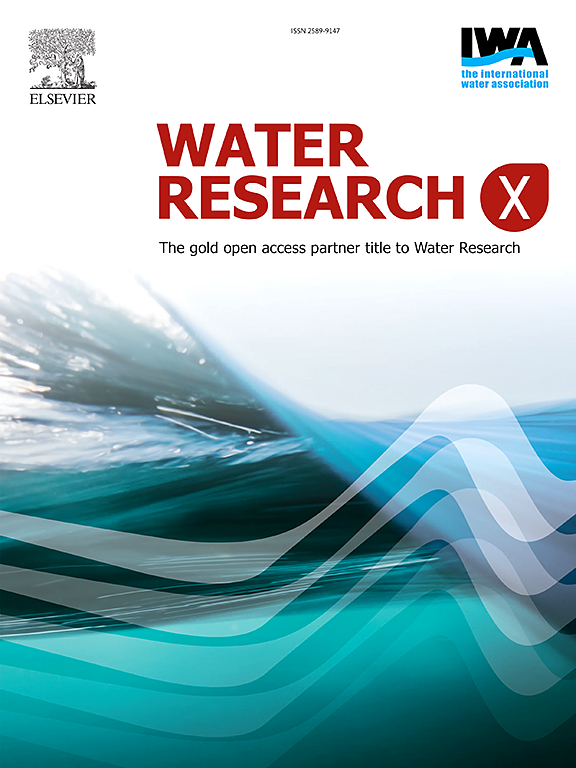砂滤出水3-8µm微生物颗粒的实时检测作为细小隐孢子虫卵囊的替代指标
IF 8.2
2区 环境科学与生态学
Q1 ENGINEERING, ENVIRONMENTAL
引用次数: 0
摘要
通过饮用自来水暴发的隐孢子虫感染是对公众健康的重大威胁。监测砂滤出水中隐孢子虫卵囊大小的微生物作为隐孢子虫卵囊的替代指标可以检测砂滤完整性的破坏。本研究旨在通过改造MP计数器,实现砂滤出水中与隐孢子虫相似大小的微生物颗粒(MPs)的连续监测,并验证其有效性。调整MP计数器的仪器设置(即折射率和颗粒直径)以准确检测细小隐孢子虫卵囊。改造后的MP计数器成功检测出细小隐孢子虫和隐孢子虫大小的微生物(酿酒酵母和普通小球藻)。在为期7天的全尺寸测试中,MP计数器与透析预处理相结合,在砂滤出水中以0.2-27个计数/10 mL的速度连续检测隐孢子虫大小(即3-8µm)的MPs。然而,MP浓度的变化与浊度和1-3或3-7µm颗粒计数等常规指标的变化不相关,表明这些常规指标不能保证微生物水的安全。实时监测3-8µm的MP浓度,可以通过砂过滤器早期发现潜在的隐孢子虫泄漏。及早发现水质异常,可立即采取有效对策,减少水媒原生动物暴发的风险。本文章由计算机程序翻译,如有差异,请以英文原文为准。

Real-time detection of 3–8-µm microbial particles in sand filter effluent as a surrogate indicator of Cryptosporidium parvum oocysts
Waterborne outbreaks of Cryptosporidium infection through drinking tap water are a significant threat to public health. Monitoring Cryptosporidium oocyst-sized microorganisms in sand filter effluent as a surrogate indicator of Cryptosporidium oocysts can detect sand filter integrity breaches. This study aimed to achieve the continuous monitoring of microbial particles (MPs) sized similarly to Cryptosporidium in sand filter effluent by remodeling an MP counter and demonstrating its validity. Instrumental settings of the MP counter (i.e., refractive index and particle diameter) were adjusted for accurate detection of Cryptosporidium parvum oocyst. The remodeled MP counter successfully detected Cryptosporidium parvum and Cryptosporidium-sized microorganisms (Saccharomyces cerevisiae and Chlorella vulgaris). Over a 7-d full-scale test, the MP counter coupled with dialysis pre-treatment continuously detected Cryptosporidium-sized (i.e., 3–8-µm) MPs at 0.2–27 counts/10 mL in the sand filter effluent. However, the variations in MP concentrations were not correlated with those in conventional indicators, such as turbidity and 1–3 or 3–7-µm particle counts, indicating that microbiological water safety cannot be guaranteed with these conventional indicators. Real-time monitoring of 3–8-µm MP concentrations allows for early detection of potential Cryptosporidium leaks through a sand filter. Abnormalities in water quality detected early would allow for effective countermeasures immediately, reducing the risk of waterborne protozoan outbreaks.
求助全文
通过发布文献求助,成功后即可免费获取论文全文。
去求助
来源期刊

Water Research X
Environmental Science-Water Science and Technology
CiteScore
12.30
自引率
1.30%
发文量
19
期刊介绍:
Water Research X is a sister journal of Water Research, which follows a Gold Open Access model. It focuses on publishing concise, letter-style research papers, visionary perspectives and editorials, as well as mini-reviews on emerging topics. The Journal invites contributions from researchers worldwide on various aspects of the science and technology related to the human impact on the water cycle, water quality, and its global management.
 求助内容:
求助内容: 应助结果提醒方式:
应助结果提醒方式:


